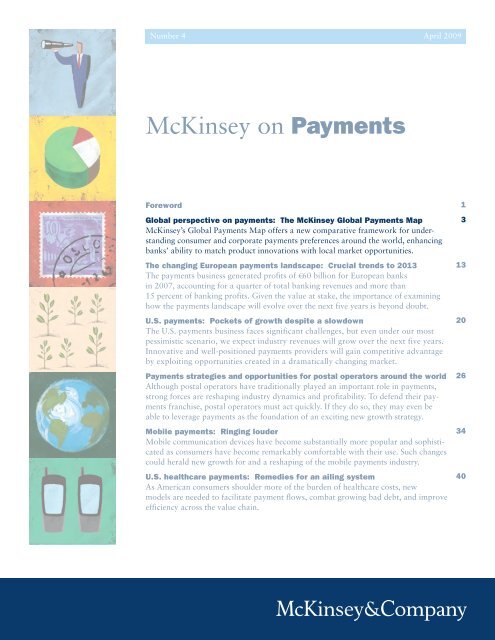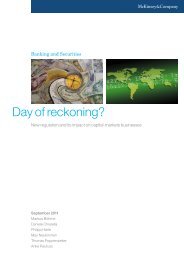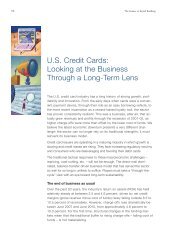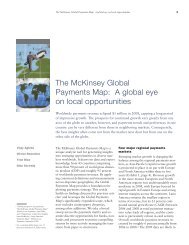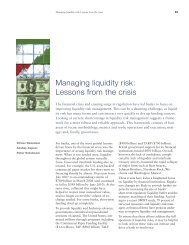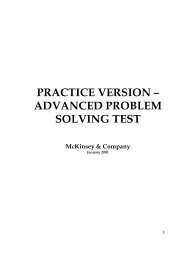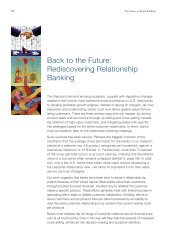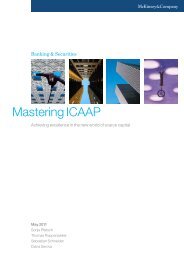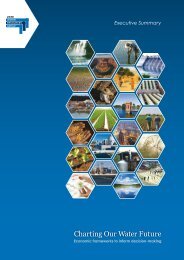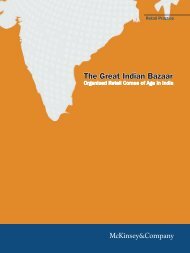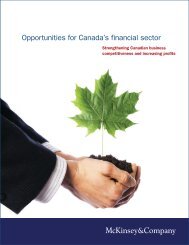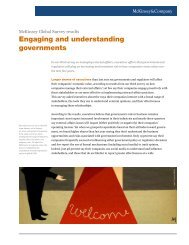McKinsey on Payments - McKinsey & Company
McKinsey on Payments - McKinsey & Company
McKinsey on Payments - McKinsey & Company
Create successful ePaper yourself
Turn your PDF publications into a flip-book with our unique Google optimized e-Paper software.
Number 4April 2009<str<strong>on</strong>g>McKinsey</str<strong>on</strong>g> <strong>on</strong> <strong>Payments</strong>ForewordGlobal perspective <strong>on</strong> payments: The <str<strong>on</strong>g>McKinsey</str<strong>on</strong>g> Global <strong>Payments</strong> Map<str<strong>on</strong>g>McKinsey</str<strong>on</strong>g>’s Global <strong>Payments</strong> Map offers a new comparative framework for understandingc<strong>on</strong>sumer and corporate payments preferences around the world, enhancingbanks’ ability to match product innovati<strong>on</strong>s with local market opportunities.The changing European payments landscape: Crucial trends to 2013The payments business generated profits of €60 billi<strong>on</strong> for European banksin 2007, accounting for a quarter of total banking revenues and more than15 percent of banking profits. Given the value at stake, the importance of examininghow the payments landscape will evolve over the next five years is bey<strong>on</strong>d doubt.U.S. payments: Pockets of growth despite a slowdownThe U.S. payments business faces significant challenges, but even under our mostpessimistic scenario, we expect industry revenues will grow over the next five years.Innovative and well-positi<strong>on</strong>ed payments providers will gain competitive advantageby exploiting opportunities created in a dramatically changing market.<strong>Payments</strong> strategies and opportunities for postal operators around the worldAlthough postal operators have traditi<strong>on</strong>ally played an important role in payments,str<strong>on</strong>g forces are reshaping industry dynamics and profitability. To defend their paymentsfranchise, postal operators must act quickly. If they do so, they may even beable to leverage payments as the foundati<strong>on</strong> of an exciting new growth strategy.Mobile payments: Ringing louderMobile communicati<strong>on</strong> devices have become substantially more popular and sophisticatedas c<strong>on</strong>sumers have become remarkably comfortable with their use. Such changescould herald new growth for and a reshaping of the mobile payments industry.U.S. healthcare payments: Remedies for an ailing systemAs American c<strong>on</strong>sumers shoulder more of the burden of healthcare costs, newmodels are needed to facilitate payment flows, combat growing bad debt, and improveefficiency across the value chain.131320263440
The <str<strong>on</strong>g>McKinsey</str<strong>on</strong>g> Global <strong>Payments</strong> Map3Global perspective <strong>on</strong> payments:The <str<strong>on</strong>g>McKinsey</str<strong>on</strong>g> Global <strong>Payments</strong> Map<strong>Payments</strong> services generate worldwide revenues of more than $900 billi<strong>on</strong>each year. Representing roughly 25 to 30 percent of total bank revenues,payments services provide a steady income stream in these troubled timesas well as daily opportunities for banks to serve c<strong>on</strong>sumer and businesscustomers and to reinforce their brand. At the same time, payments systemspose a heavy burden <strong>on</strong> overall bank operati<strong>on</strong>s costs, making them evenmore worthy of focus.Olivier DeneckerGlen SarvadyAnna Yip<str<strong>on</strong>g>McKinsey</str<strong>on</strong>g>’s Global <strong>Payments</strong> Map marks anew analytical framework for understandingthe payments business, offering a distinctivelycomparative approach inevaluating regi<strong>on</strong>al payments dynamics andrevenue trends around the world. In separatearticles in the current editi<strong>on</strong> of <str<strong>on</strong>g>McKinsey</str<strong>on</strong>g><strong>on</strong> <strong>Payments</strong>, we focus <strong>on</strong> recentdevelopments in the U.S. and Europeanpayments markets; in forthcoming issueswe will examine trends in Asia and LatinAmerica. <str<strong>on</strong>g>McKinsey</str<strong>on</strong>g>’s Global <strong>Payments</strong>Map, built over several years with quantitativedata from a broad range of sources, revealspatterns in the evoluti<strong>on</strong> of paymentsbehaviors over time. This market typologybears important implicati<strong>on</strong>s for bank liquidityand revenue, and the <str<strong>on</strong>g>McKinsey</str<strong>on</strong>g>Global <strong>Payments</strong> Map will help banks toanticipate local market changes throughcomparis<strong>on</strong> with markets that display similarpatterns of change.As payments is an increasingly globalizedbusiness, banks need to articulate localstrategies to address global competitivethreats, applying less<strong>on</strong>s from around theworld to enhance the l<strong>on</strong>gevity and profitabilityof each customer relati<strong>on</strong>ship. Ashighlighted in previous papers, the interdependencyof transacti<strong>on</strong>s and liquidities is aglobal characteristic of the payments business.(See “The hidden side of payments:Harnessing the value of liquidity,” <str<strong>on</strong>g>McKinsey</str<strong>on</strong>g><strong>on</strong> <strong>Payments</strong>, November 2008.) Transacti<strong>on</strong>services attract customer depositsand loans and offer banks a lever to expandtheir franchise into new geographies, marketsegments and product groups. Past ex-
4 <str<strong>on</strong>g>McKinsey</str<strong>on</strong>g> <strong>on</strong> <strong>Payments</strong> April 2009Exhibit 1<strong>Payments</strong> represent<strong>on</strong>e-quarter of totalbanking revenues orU.S.$900 billi<strong>on</strong>Total 2007 bankingrevenues breakdownPercent100% = U.S.$3,400 billi<strong>on</strong>2007 payments revenuesdecompositi<strong>on</strong>U.S.$ billi<strong>on</strong>sU.S.282Europe2757327AsiaPacific237LatinAmerica*60N<strong>on</strong>-payments<strong>Payments</strong>Rest ofWorld60* Latin America data is for 2006Source: <str<strong>on</strong>g>McKinsey</str<strong>on</strong>g> Global <strong>Payments</strong> MapTotal914perience has shown, however, that “<strong>on</strong>e sizefits all” soluti<strong>on</strong>s (e.g., U.S.-style revolvingcard soluti<strong>on</strong>s in Europe) face major hurdles.Understanding the differences in theglobal payments landscape, therefore, enablesbankers to rethink enterprise strategiesto compete locally.In order to understand the differencesam<strong>on</strong>g the world’s major payments markets,we return to the basics: how customersmake payments, how they fund these transacti<strong>on</strong>sand how banks charge them for theservices rendered. Determining how to balancethese three aspects of the paymentsbusiness into a profitable mix is the keychallenge for banks entering a new marketor dealing with changing ec<strong>on</strong>omic fundamentals.A tour of the payments globe,guided by <str<strong>on</strong>g>McKinsey</str<strong>on</strong>g>’s Global <strong>Payments</strong>Map, provides valuable less<strong>on</strong>s for banksseeking to optimize income from balanceswhile also optimizing the cost and revenueof transacti<strong>on</strong> services.Global perspective <strong>on</strong> paymentsrevenuesWhen looking at the Global <strong>Payments</strong> Map,the three largest regi<strong>on</strong>al markets by revenueare the U.S., Europe and the Asia-Pacificregi<strong>on</strong>. Together with Latin America,these regi<strong>on</strong>s represent more than 90 percentof banks’ global payments revenues(Exhibit 1). Overall, fees and net interest income<strong>on</strong> payments-related accounts representabout 50 percent each of the revenuebase, reinforcing the noti<strong>on</strong> that paymentsis a “hybrid business”: transacti<strong>on</strong> servicesare fundamental to persuading customers eitherto carry loan balances (credit card oroverdraft) or to increase their deposits.Up<strong>on</strong> closer examinati<strong>on</strong>, however, paymentsrevenue models vary significantlyfrom <strong>on</strong>e regi<strong>on</strong> to another. In the UnitedStates fees account for more than half oftotal payments revenues. By c<strong>on</strong>trast, in Europeand Asia-Pacific most payments-relatedrevenues are derived from current
The <str<strong>on</strong>g>McKinsey</str<strong>on</strong>g> Global <strong>Payments</strong> Map5Exhibit 2Revenue driversdiffer str<strong>on</strong>glyby regi<strong>on</strong>2007 revenuesU.S.$ billi<strong>on</strong>sCurrent accountsc<strong>on</strong>sumerU.S. Europe Asia Pacific95.4145.1Fee income69.3Interest incomeCurrent accountscommercial31.786.4114.6Credit card issuing128.629.732.6Card acquiring11.211.413.2Other14.72.27.0Total281.6274.8236.7Source: <str<strong>on</strong>g>McKinsey</str<strong>on</strong>g> Global <strong>Payments</strong> Map1Electr<strong>on</strong>ic payments (debit or credittransfers) move funds directly from <strong>on</strong>eaccount to another, either as a debit or credittransacti<strong>on</strong> in the batch system or as credittransacti<strong>on</strong> in the real-time gross settlementsystem (RTGS).account balances, with fees amounting to<strong>on</strong>e-third of payments revenue in each regi<strong>on</strong>(Exhibit 2). High interest rates in 2007c<strong>on</strong>tributed to a significant rise in interestincome to the payments business, particularlyin Europe and Asia-Pacific, where bothc<strong>on</strong>sumers and businesses hold large cashreserves in current accounts. Given the recentshifts in global interest margins amidstthe current ec<strong>on</strong>omic crisis, it is reas<strong>on</strong>ableto assume that payments revenue growthwill moderate in 2008-09, or perhaps showsome decline, particularly in countries witha heavy reliance <strong>on</strong> interest as a share ofpayments revenue. N<strong>on</strong>etheless, the overallhealth of payments revenues is solid andtheir l<strong>on</strong>g-term status as 25 to 30 percent oftotal banking revenues is secure.The c<strong>on</strong>tributi<strong>on</strong> of retail versus commercialaccounts also differs markedly by regi<strong>on</strong>.In the U.S. more than three-quartersof current account revenue is derived fromc<strong>on</strong>sumers. In Asia-Pacific, however, themajority is generated by business accounts.In Europe the balance tilts toward retail accountsbut not as heavily as in the U.S. Beforeexamining more closely thecompositi<strong>on</strong> of payments revenue in diversemarkets, we discuss the customer paymentspreferences and liquidity practices that distinguishthese markets.Back to basics: Building a globalpayments strategyThe payments business fills three basicneeds: transacti<strong>on</strong>s and liquidity for the userand, in return, revenue for the bank. Banksserve these needs with a narrow set of products.They serve customers’ transacti<strong>on</strong>needs with four main tools: cash, checks,cards and electr<strong>on</strong>ic payments. 1 As for liquidity,customers may fund these transacti<strong>on</strong>simmediately out of existing assets(deposits), defer transacti<strong>on</strong> settlement (aswith a charge card) or spend out of deficit(revolving balances <strong>on</strong> a line of credit). Cus-
6 <str<strong>on</strong>g>McKinsey</str<strong>on</strong>g> <strong>on</strong> <strong>Payments</strong> April 2009Regi<strong>on</strong>al scope of <str<strong>on</strong>g>McKinsey</str<strong>on</strong>g> payment pools<str<strong>on</strong>g>McKinsey</str<strong>on</strong>g>’s European Payment Pools reflect activities of the European Uni<strong>on</strong> countries (EU27) excluding Luxembourg, Latvia,Lithuania, Est<strong>on</strong>ia, Malta and Cyprus, but including Norway and Switzerland.The Asian Payment Pools comprise the entirety of the Asia-Pacific regi<strong>on</strong>, with detailed analysis of the following ten leading ec<strong>on</strong>omies (in descendingorder of payments revenue): China,Australia, Japan, South Korea, India,Thailand, H<strong>on</strong>g K<strong>on</strong>g, Malaysia, Ind<strong>on</strong>esia and Singapore.Latin America is the most recent additi<strong>on</strong> to <str<strong>on</strong>g>McKinsey</str<strong>on</strong>g>’s regi<strong>on</strong>al payment pool initiative, c<strong>on</strong>sisting of ec<strong>on</strong>omics for Brazil,Mexico, Argentina, Chile, Colombia and Peru. A further discussi<strong>on</strong> of this regi<strong>on</strong>’s dynamics will be provided in a forthcoming issue of<str<strong>on</strong>g>McKinsey</str<strong>on</strong>g> <strong>on</strong> <strong>Payments</strong>.The prominent comp<strong>on</strong>ents of the Rest of World category include Russia, Turkey, Canada and the Middle East and Africa. Further analysesof these geographies are under way.Currency translati<strong>on</strong>s are an unavoidable factor in determining regi<strong>on</strong>al shares and overall growth rates. We employ the U.S. dollaras the comm<strong>on</strong> denominator, using average annual exchange rates.Due to the central banks’ varied release schedules for key supporting data, we c<strong>on</strong>tinue to refine our 2007 metrics. As a result,subsequent versi<strong>on</strong>s of <str<strong>on</strong>g>McKinsey</str<strong>on</strong>g>’s regi<strong>on</strong>al profit pools may differ nominally from these figures.For more informati<strong>on</strong> <strong>on</strong> <str<strong>on</strong>g>McKinsey</str<strong>on</strong>g>’s Global Payment Pools initiative, please c<strong>on</strong>tact paymentspractice@mckinsey.com.Victor Ban, a c<strong>on</strong>sultant in the Taipei office, Ryan Cope, a senior analyst in <str<strong>on</strong>g>McKinsey</str<strong>on</strong>g>’s Global C<strong>on</strong>cepts office, Reynaldo Sandoval, a c<strong>on</strong>sultant in the Mexico City office,and Edm<strong>on</strong>d Vrancken, a senior analyst in the Paris office, c<strong>on</strong>tributed research for this article.tomers compensate banks for these serviceswith either fees or interest, or a combinati<strong>on</strong>of the two. Whatever a given market’s fundamentalrevenue model may be, banks inall regi<strong>on</strong>s operate certain services at a loss(in many cases, cash and check processing),others at a profit (usually deposits and lending).Banks therefore require complex toolsto manage profitability across a diverse setof accounts and services.How customers make paymentsGeneral payment preferences by regi<strong>on</strong>In the U.S., credit cards and checks – despitethe latter’s steady decline am<strong>on</strong>g c<strong>on</strong>sumers– stand out as particularly important forc<strong>on</strong>sumers and businesses alike. The situati<strong>on</strong>in Europe and Asia-Pacific is more diverse,as countries differ str<strong>on</strong>gly in theirpreference of cash versus cards for point-ofsale(POS) transacti<strong>on</strong>s and checks versuselectr<strong>on</strong>ic payments for bill payments. Somemarkets, such as France, Canada and H<strong>on</strong>gK<strong>on</strong>g, show a preference pattern not unlikethat of the U.S., with relatively high usageof checks and cards and less use of electr<strong>on</strong>ictransfers.In Europe, a major gap separates countriesthat are highly electr<strong>on</strong>ified, both in transfersand card usage, such as the Nordic andBenelux countries, and those with an enduringstr<strong>on</strong>g preference for cash, such as Italy,Spain and Germany. Similarly, Japan andInd<strong>on</strong>esia show no attachment to checks,relatively high usage of electr<strong>on</strong>ic payments,but also a clear bias towards cashrather than cards. Thus, as Exhibit 3shows, countries that are geographicallyand culturally close often follow diversetrajectories toward full payments electr<strong>on</strong>ificati<strong>on</strong>,due not <strong>on</strong>ly to varying customerpreferences but also to differences in governmentregulati<strong>on</strong>, the distributi<strong>on</strong> of paymentstechnology and the pricing of cashversus cards. (For more <strong>on</strong> this, see “ATMs:Complex weap<strong>on</strong>s in the war <strong>on</strong> cash,”<str<strong>on</strong>g>McKinsey</str<strong>on</strong>g> <strong>on</strong> <strong>Payments</strong>, November 2008.)
The <str<strong>on</strong>g>McKinsey</str<strong>on</strong>g> Global <strong>Payments</strong> Map7Exhibit 3Basic typology ofpayments markets2007 transacti<strong>on</strong>s dataElectr<strong>on</strong>icPolandJapanNetherlandsFinlandInd<strong>on</strong>esiaChinaGermanyItalyBrazilSpainSouthKoreaU.K.AustraliaShare ofelectr<strong>on</strong>ictransacti<strong>on</strong>srelative tocheck*RussiaColombiaFranceCanadaMexicoMalaysiaH<strong>on</strong>g K<strong>on</strong>gU.S.* Electr<strong>on</strong>ic c<strong>on</strong>sists of credit transfersand direct (ACH) debits; for thispurpose it excludes card transacti<strong>on</strong>s** Excluding ePurse and prepaidSource: <str<strong>on</strong>g>McKinsey</str<strong>on</strong>g> Global <strong>Payments</strong> MapCheckIndiaArgentina0 185Debit & credit card transacti<strong>on</strong>s per capita**2“Volume” throughout this article refers tothe total number, not value, of transacti<strong>on</strong>s.Cash: Important everywhereAlthough cash usage is shrinking across theworld, it remains the most frequently usedpayment instrument in most countries and isparticularly str<strong>on</strong>g in some of the world’slargest developing markets: China, India,Brazil and Russia. Cash is also prevalent inseveral mature ec<strong>on</strong>omies such as Japan andGermany. In the United States, cash accountsfor an estimated 57 percent of totalpayments volume 2 and, in Europe, rangesfrom 47 percent (Finland) to almost 95 percent(Poland). The variati<strong>on</strong> in cash usagebetween “cash ec<strong>on</strong>omies” and “electr<strong>on</strong>ifyingec<strong>on</strong>omies” in Asia-Pacific is similarlywide, from 61 percent in H<strong>on</strong>g K<strong>on</strong>g andAustralia to 99 percent in India (Exhibit 4<strong>on</strong> page 10). Banks in diverse markets canadvance the “war <strong>on</strong> cash” (and reduce thecosts of cash processing) by promoting electr<strong>on</strong>icand card payments and alternativepayment channels, such as Globe’s GCash, amobile payments initiative in the Philippines.(For more <strong>on</strong> mobile payments, see“Mobile payments: Ringing louder” <strong>on</strong>page 34 of this issue.)Cards: Extending their reachRapid improvements in nati<strong>on</strong>al telecommunicati<strong>on</strong>sinfrastructures reduce the costof extending card acceptance technology tomerchants of various sizes, even in remotelocati<strong>on</strong>s. Thus, card growth is str<strong>on</strong>g inemerging markets, particularly in cash-intensiveIndia and China, but usage c<strong>on</strong>tinuesto grow at close to double-digit rateseven in highly developed markets, e.g.,Scandinavia. Expanding acceptance to publicand semi-public agencies (e.g., hospitals)and other high-volume locati<strong>on</strong>s can spurcard growth significantly, as is happening inJapan, where the growth rate of card transacti<strong>on</strong>shas increased more than threefoldsince 2005.While levels of card usage and the resultingrevenue each depend <strong>on</strong> a variety of factors(including interchange rates, mix ofdebit/credit and annual maintenance fees),
8 <str<strong>on</strong>g>McKinsey</str<strong>on</strong>g> <strong>on</strong> <strong>Payments</strong> April 2009those countries where card usage is relativelylow may see the greatest opportunityfor growth in both card transacti<strong>on</strong>s andrevenue. For example, Germany’s 36 cardtransacti<strong>on</strong>s per capita per year is low byEuropean standards, and China’s <strong>on</strong>e transacti<strong>on</strong>per capita is distorted by a high unbankedpopulati<strong>on</strong>. Card transacti<strong>on</strong>revenue in these countries (i.e., debit andcredit, excluding interest) accounts for 6percent and 10 percent of total paymentsrevenue, respectively, suggesting an untappedreserve of revenue from transacti<strong>on</strong>volume. By c<strong>on</strong>trast, in markets like theU.S., with 177 card transacti<strong>on</strong>s per capitaper year, and South Korea, with 63, (a relativelyhigh figure compared to the Asian peergroups) cards c<strong>on</strong>tribute 33 percent and 44percent of total payments revenue, respectively,and the prospects for further revenuegrowth from cards are more measured.Checks: Declining but impossibleto ignoreWhile checks have l<strong>on</strong>g provided the mainalternative to cash in certain countries, theirrelative importance globally is declining rapidly.In countries such as Finland or theNetherlands, checks have actually ceased toexist, which is expected to happen so<strong>on</strong> inmost of northwest Europe as well. As a resultof these trends, check usage is now increasinglyc<strong>on</strong>centrated in North America, afew European countries (e.g., France andthe U.K.) and Latin America, where theproduct proves difficult to replace, due pri-Internati<strong>on</strong>al glossary of paymentsWhile the core offerings of a payments franchise are c<strong>on</strong>sistent from <strong>on</strong>e regi<strong>on</strong> to another, different markets use a variety of English-languageterms to identify the same services. Bankers, therefore, need not <strong>on</strong>ly to understand the distinct behaviors and c<strong>on</strong>venti<strong>on</strong>s of local marketsbut also regi<strong>on</strong>al differences in the payments lexic<strong>on</strong>. The glossary below lists the alternative names for the products discussed in this article.ServiceCard acquirerCharge cardCredit cardCredit card issuerCredit transferAlternative namesMerchant acquirerDeferred debit card,credit cardRevolving credit cardACH credit (in the U.S.);also (in Europe) giro paymentand direct creditDescripti<strong>on</strong>The bank that provides merchants and billers with technology for accepting card transacti<strong>on</strong>sand processes card payments <strong>on</strong> their behalf. Acquirer revenue is based <strong>on</strong> technologyimplementati<strong>on</strong> and taking a small porti<strong>on</strong> of the “discount rate” <strong>on</strong> each transacti<strong>on</strong>.Card allowing holder to charge purchases to a card account up to an authorized limit.Card does not offer extended credit and the full amount of the debt incurred is settledat the end of a specified period. Most cards referred to as “credit cards” in c<strong>on</strong>tinentalEurope are actually “charge cards.”Card allowing holder to charge purchases against a line of credit up to an authorizedamount, with the opti<strong>on</strong> to pay a porti<strong>on</strong> of the balance at the end of a specified periodand “revolve” the remaining balance indefinitely. Customer pays interest <strong>on</strong> the revolvedbalance. In countries where deficit spending is prevalent, credit card holders tend to be“revolvers”; in countries where c<strong>on</strong>sumers maintain high current account balances, theytend to be “transactors,” using credit cards as a form of “deferred debit.”The bank that issues the credit card and associated credit line to the customer. Card issuerrevenue comes from interchange (merchant discount rate), and interest <strong>on</strong> revolvingbalances (in some countries) or membership fees (in other countries), as well as incidentalfees (for late payment and transacti<strong>on</strong>s that exceed the credit limit).Electr<strong>on</strong>ic payment where both payment instructi<strong>on</strong>s and funds move from payor bank topayee bank via batch-transfer system. Traditi<strong>on</strong>ally low-value.
The <str<strong>on</strong>g>McKinsey</str<strong>on</strong>g> Global <strong>Payments</strong> Map9marily to existing corporate billing systems.Two countries, France and the UnitedStates, account for nearly two-thirds ofworldwide check volumes.In some developing markets checks neverreally took hold due to limited negotiabilityand expense. Checks in China, for example,are <strong>on</strong>ly valid in the regi<strong>on</strong> of the drawer’sbank rather than nati<strong>on</strong>wide. As checks arenow becoming obsolete, emergingec<strong>on</strong>omies can safely avoid investing in newcheck infrastructure.Electr<strong>on</strong>ic transfers: Str<strong>on</strong>g in mostdeveloped ec<strong>on</strong>omiesElectr<strong>on</strong>ic payments are an operati<strong>on</strong>ally efficientsoluti<strong>on</strong> and have become a fixturein many developed markets, both for c<strong>on</strong>sumerand corporate payments. Although inthe U.S., France and Canada migrati<strong>on</strong> hasbeen less successful. Reas<strong>on</strong>s can be foundin systemic restricti<strong>on</strong>s <strong>on</strong> c<strong>on</strong>sumer-initiatedtransfers or the reluctance of c<strong>on</strong>sumersto share account numbers, theprocess layout for batch-transfer electr<strong>on</strong>icpayments, and higher fees. In the U.S. andFrance banks make around $1.00 per electr<strong>on</strong>icpayment versus just below $0.40 inGermany or Brazil.Electr<strong>on</strong>ic payments processed throughbatch-transfer systems (e.g., ACH) poseboth challenges and opportunities forbanks. As more people in emerging marketsare integrated into the banking system, electr<strong>on</strong>icpayments are often the best alterna-ServiceCurrent accountDebit cardDirect debitOverdraftRTGS (real timegross settlement)paymentVolumeAlternative namesDemand deposit account(DDA) is morecomm<strong>on</strong> in the U.S.ACH debitNSF/OD(N<strong>on</strong>-sufficientfunds/overdraft)Wire transfer(in the U.S.)Descripti<strong>on</strong>Fully liquid deposit account allowing, without systematic limits for transacti<strong>on</strong>s, payments to allother endpoints. In some cases, current account balances earn interest.A card linked to a deposit account (usually a current account, in some cases a savings account)and used for POS purchases and ATM cash withdrawals. Transacti<strong>on</strong>s are funded immediately(with PIN-based authorizati<strong>on</strong>) or at the end-of-day (with signature-based authorizati<strong>on</strong>).Pre-authorized batch-transfer electr<strong>on</strong>ic payment where payment instructi<strong>on</strong>s move from payeebank to payor bank and funds move in the opposite directi<strong>on</strong>. Traditi<strong>on</strong>ally low-value.A debit transacti<strong>on</strong> that exceeds the amount of funds in the account. The bank may either rejectthe transacti<strong>on</strong> or pay it by extending credit to the customer (whether by previous arrangementwith the customer or as a “courtesy”). Bank may charge a fee and/or interest (e.g., in the U.S.there is a higher tolerance of “incident” fees than in other regi<strong>on</strong>s). Typically overdraft refers tothe incident in the U.S. and to the resulting balance in Europe.Real time transfer of funds, executed individually <strong>on</strong> an order-by-order basis. Mostlyhigh-value, business-to-business transacti<strong>on</strong>s and often executed through SWIFT system(except in the U.S.).Refers to the total number of transacti<strong>on</strong>s (e.g., check items processed). This differs fromvalue, which for the purposes of the <strong>Payments</strong> Map refers to the dollar (or other currency) flowrepresented by those transacti<strong>on</strong>s.
10 <str<strong>on</strong>g>McKinsey</str<strong>on</strong>g> <strong>on</strong> <strong>Payments</strong> April 2009Exhibit 4Cash remainsimportant everywhere* 2006 data for Brazil, Colombiaand MexicoSource: <str<strong>on</strong>g>McKinsey</str<strong>on</strong>g> Global <strong>Payments</strong> Map2007* share of cash transacti<strong>on</strong>sPercentInd<strong>on</strong>esiaIndiaColombiaRussiaChinaMexicoPolandBrazilMalaysiaItalyJapanGermanySouth KoreaCanadaAustraliaU.K.H<strong>on</strong>g K<strong>on</strong>gNetherlandsU.S.FranceSwedenFinland47616161605755546675759493918988999999989898Cashec<strong>on</strong>omiesElectr<strong>on</strong>ifyingtive to cash for bill payment. Furthermore,in many countries, c<strong>on</strong>sumers can initiate<strong>on</strong>e-time credit transfers to both businessesand individuals alike. In India, the governmentis promoting electr<strong>on</strong>ic payments as away to reduce the number of cash paymentsand extend c<strong>on</strong>trol and transparency to theinformal ec<strong>on</strong>omy. The fast growth of electr<strong>on</strong>icvolumes in the emerging markets ofChina and India has important implicati<strong>on</strong>sfor fee revenue in the Asian payments business,as electr<strong>on</strong>ic payments are already amajor source of fee revenue.How customers fund transacti<strong>on</strong>sEach payments instrument is linked to asource of liquidity – cash <strong>on</strong> hand or debt financingthrough a credit line. Funding canbe attached to different instruments: a currentaccount, a credit line or a sock drawer.General funding preferences by regi<strong>on</strong>The way customers of a given regi<strong>on</strong> fundtransacti<strong>on</strong>s and manage their liquidity parallelsin a very general way each regi<strong>on</strong>’strade balance. The success of credit cards inthe U.S. payments system is unquesti<strong>on</strong>ablylinked with the dependence of the U.S. ec<strong>on</strong>omy<strong>on</strong> deficit spending. Year after year,credit cards have added steam to the U.S.ec<strong>on</strong>omy by allowing c<strong>on</strong>sumers to buynow, pay later. In Europe and Asia-Pacific,however, c<strong>on</strong>sumers are net lenders to thebanking system, saving up more than theyborrow and managing their spendingthrough current accounts, where they tendto hold relatively large balances.Different funding preference also determinesmarket preference for either debit orcredit cards. In the United States, Ireland,and the U.K., as well as Asia-Pacific countriessuch as Australia, H<strong>on</strong>g K<strong>on</strong>g andSouth Korea, where credit card use isstr<strong>on</strong>g, customers frequently finance purchasesby revolving balances. C<strong>on</strong>tinentalEuropean markets including Germany, theBenelux and Nordic countries, as well as
The <str<strong>on</strong>g>McKinsey</str<strong>on</strong>g> Global <strong>Payments</strong> Map11major Asian countries including China,show a preference for debit, paying for purchasesout of their current accounts. C<strong>on</strong>sumersin France, Spain and Japan,meanwhile, prefer to use credit cards as a“deferred debit” instrument. That is, theydefer settlement of the transacti<strong>on</strong> to theend of the billing cycle, often with an automaticdebit out of their current account.In many European and Asia-Pacific markets,current account balances exceed theamount needed to fund routine transacti<strong>on</strong>seven in peak spending m<strong>on</strong>ths. The abilityof banks to retain excess balances in highmarginaccounts helps sustain their profitability,and signs of erosi<strong>on</strong> of suchsurpluses amid the current financial crisisare emerging in some markets. N<strong>on</strong>-transacti<strong>on</strong>alfees (account maintenance fees plusinterest income) <strong>on</strong> current accounts rangefrom more than $600 per capita for muchof Western Europe, to $400 to $500 percapita in developed markets of Asia-Pacificand Latin America, to less than $200 percapita in the U.S.Changes in corporate liquiditymanagementAs debt is often an integral part of corporateliquidity structure, treasurers may seekto offset interest expense with higher returns<strong>on</strong> liquid reserves. Poor current performanceof alternative investments and reducedcredit are, however, forcing corporati<strong>on</strong>s tohold more <strong>on</strong> liquid reserve. Indeed, the currentfinancial crisis is changing corporatebehavior rapidly, especially in Asia-Pacific.Commenting <strong>on</strong> new challenges to l<strong>on</strong>g-establishedpractices in corporate cash management,<strong>on</strong>e Asian bank executive told us,“The changes of the past three m<strong>on</strong>ths [4thquarter of 2008] are greater than those ofthe previous ten years.” Corporati<strong>on</strong>s,whose large current account balances havebeen the single largest source of cash managementrevenue for Asia-Pacific banks, areincreasingly eager to optimize their use offunds. This could signal an important shiftin the revenue stream for the Asia-Pacificpayments business, as treasurers look forhigher returns, minimizing balances in currentaccounts, using netting systems andworking capital optimizati<strong>on</strong> tools to reacha higher return.Such a change in corporate behavior couldresult in a loss of interest income to a bank’spayments business, but banks that offer newliquidity management opti<strong>on</strong>s may still beable to retain corporate deposits and evenattract new deposits. For example, somebanks in Asia-Pacific have recently beenpromoting working capital management accountsfor small businesses, offering smalland medium-size enterprises (SMEs) moreflexibility in funds management and providinghigher returns than traditi<strong>on</strong>al currentaccounts. As SMEs account for two-thirdsof cash management revenue worldwide,banks should be careful to retain their deposits,even if this means shifting revenueaway from the transacti<strong>on</strong>al business.Banks’ ability to offer transacti<strong>on</strong> servicesrepresents a means for them to attract additi<strong>on</strong>alliquidity, provided banks are seen assafe havens.How customers compensate banksAs shown in Exhibit 2 <strong>on</strong> page 5, paymentsrevenue in Europe and the Asia-Pacific regi<strong>on</strong>c<strong>on</strong>sists mainly of interest income,while in the U.S., fees c<strong>on</strong>tribute the largerporti<strong>on</strong>. Within Europe, fee levels varystr<strong>on</strong>gly, and sensitivities to different typesof fees are apparent. Asia-Pacific customers,both c<strong>on</strong>sumers and businesses, tend tocompensate banks with high balances, andfees represent a substantial porti<strong>on</strong> of revenues<strong>on</strong>ly <strong>on</strong> corporate accounts.While at first glance, Exhibit 2 suggests thatU.S. c<strong>on</strong>sumers are more tolerant of feesthan their peers in Europe and Asia-Pacific,they have, in fact, essentially rejected periodic“maintenance” and “membership”fees, which have become rare both for currentaccounts and credit cards. On the otherhand French and German customers generallyavoid transacti<strong>on</strong> fees, but are comfortablepaying account “maintenance” or card
12 <str<strong>on</strong>g>McKinsey</str<strong>on</strong>g> <strong>on</strong> <strong>Payments</strong> April 2009“membership” fees upfr<strong>on</strong>t. In turn, U.S.c<strong>on</strong>sumers pay out higher credit card interest,receive lower returns <strong>on</strong> current accountbalances, and pay higher incident fees forthe c<strong>on</strong>venience of using ATMs, overdrawinga current account, exceeding a creditlimit or making a late payment. In otherwords, U.S. c<strong>on</strong>sumers compensate banksmore readily for the debt financing aspect ofliquidity management than for transacti<strong>on</strong>sfunded with cash reserves. A similar structureholds in the U.K. C<strong>on</strong>sequently, interest<strong>on</strong> revolving credit card balances accountsfor approximately 25 percent of total paymentsrevenues in the U.S., Mexico andH<strong>on</strong>g K<strong>on</strong>g but less than 2.5 percent in “deposit-oriented”countries like Germany, theNetherlands and Japan.Some markets resist fees more str<strong>on</strong>gly thanothers, and the balance of fee and interestincome that works in <strong>on</strong>e country maywork poorly in another. However, countriesthat look extremely different in paymentsSuccessful innovati<strong>on</strong>s in Japan maywork better in Germanythan in the U.S.; Mexico may learn morefrom Malaysia than from Brazil.behavior and revenue models can actuallybe very close in total revenue relative to operati<strong>on</strong>aloutput. For example, whereas thetotal payments revenue per n<strong>on</strong>-cash transacti<strong>on</strong>ranges from $1.50 to over $15.00across all markets, markets as different asBrazil, the U.S., South Korea, the U.K. andFrance fall within a 10 percent range ofeach other.Comparative market analysis of customerbehaviors and their ways of compensatingbanks can provide crucial less<strong>on</strong>s to banksas they seek to optimize the return fromeach relati<strong>on</strong>ship while also strengtheningcustomer loyalty. This is the <strong>on</strong>ly way forglobal banks to protect their payments franchisefrom specialists that seek to “cherrypick” the profitable products and servicesand threaten to reduce full-service banks toloss-making payments “utilities.”* * *The payments market is changing in fast,dramatic ways, and the forces of globalizati<strong>on</strong>,combined with the current restructuringof the financial services sector, demand amore structured approach to balancingprofit across multiple accounts and services.Transacti<strong>on</strong> services serve both to tie customersto the bank and to encourage themto leave more <strong>on</strong> deposit with the bank, andthis link between payments and liquidity isvital in any market. The key challenge forany payments franchise is striking the optimalbalance of interest income and fee incomefor a specific market.When rethinking the strategy for paymentsaccounts and services or introducing a newtechnology to a local market, a comparis<strong>on</strong>with behaviors observed in other marketscan be instructive. It is crucially important,however, to base a search for useful comparis<strong>on</strong>s<strong>on</strong> market similarities in payments behavior,rather than less pertinent factorssuch as mere size or geographical proximity.Successful innovati<strong>on</strong>s in Japan, for example,may work better in Germany than inthe U.S.; Mexico may learn more fromMalaysia than from Brazil. Each market isunique, and the course it will follow towardelectr<strong>on</strong>ificati<strong>on</strong> will vary according to cultural,ec<strong>on</strong>omic and regulatory factors.Bankers who take a global view of paymentscan chart the various possible trajectoriesa given market may follow as cardsand electr<strong>on</strong>ic volumes grow and cash graduallydeclines. Think globally, act locally.Olivier Denecker is a <strong>Payments</strong> Practice seniorknowledge expert in the Brussels office; Glen Sarvadyis a senior expert in payments in the Atlanta officeof Global C<strong>on</strong>cepts, a wholly-owned subsidiary of<str<strong>on</strong>g>McKinsey</str<strong>on</strong>g> & <strong>Company</strong>; and Anna Yip is a principalin the H<strong>on</strong>g K<strong>on</strong>g office.


